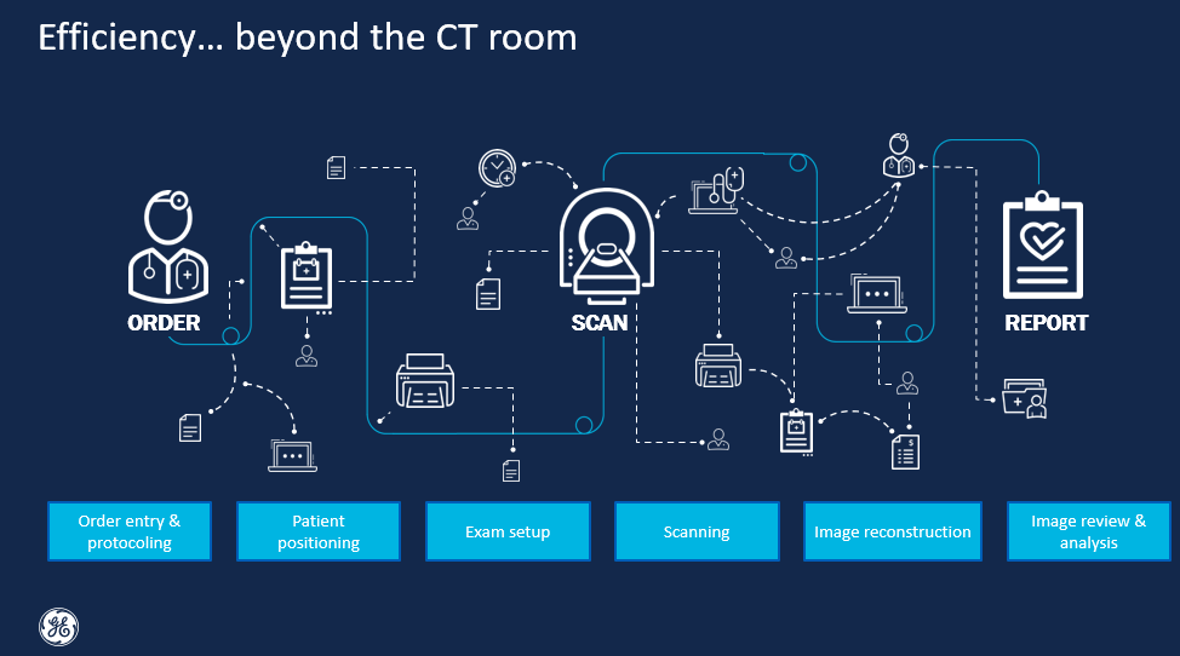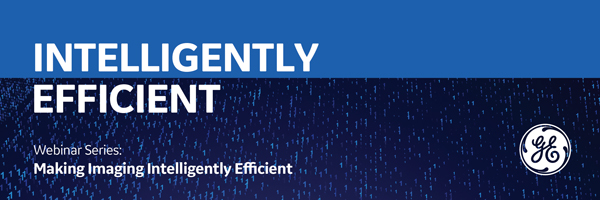Medical imaging exams with complex scanning protocols and processing requirements are being performed on a regular basis, and the volume of medical imaging data has grown exponentially due to the advances in imaging technology. Implementing effective workflow solutions to accommodate all the necessary requirements for each and every exam has become more challenging, but it is imperative to try to increase efficiencies and operate with maximum productivity and detailed resource planning in computed tomography (CT).
A recent webinar hosted by GE Healthcare took a deep dive into some of the challenges in the CT workflow and some of the ways those challenges are being addressed. Tim Szczykutowicz, PhD, DABR, Associate Professor in the University of Wisconsin School of Medicine and Public Health Departments of Radiology, Medical Physics, and Biomedical Engineering, outlines some key examples illustrating how institutions are finding ways to become more efficient in CT, using technology to help automate and simplify tasks.
Optimal Resource Planning and Protocol Uniformity
The webinar, “Effortless Workflow: Automated Support from Order to Report” featured Dr. Szczykutowicz’s insights on optimizing the radiology workflow in CT, based on the operations at his own facility, as well as others. He shared examples of new technologies that are assisting radiologists and technologists, as they are endlessly trying to do more in less time.
The radiology workflow begins at the moment a primary or referring physician orders an advanced imaging test for a patient and concludes with the radiologist’s interpretation. Each exam that is ordered can have many facets, such as using contrast or not, and number of phases in the exam. The patient will need to be contacted to schedule the exam and learn how to prepare for it.
Meanwhile, the imaging staff needs to manage scheduling patients with the right scanners. According to Dr. Szczykutowicz, this task is highly non-trivial. Technologists need to associate a specific protocol on the scanner with the order that was given or the protocol. The scanner might need additional programming for some of the patients or characteristics, such as heights and weights. Protocols for contrast injectors are also very complex. Managing the device settings for the different protocols in each exam is time consuming, but also needs to be consistent so that it’s repeatable.
“If you look at what a single recon [reconstruction] actually needs,” Dr. Szczykutowicz explained, “we’re talking about roughly 12 different adjustable parameters. We wrote a paper for JCR where we noted something like 700,000 different parameters that I’ve got to manage and adjust on our CT scanners. So even if I am wrong just one percent of the time, that’s 3,000 errors I’ve made. Additionally, I don’t want to have different flavors of the same protocol circulating around my fleet. If a patient has one exam and then a different exam for the same indication, the radiologist can’t make direct image-to-image comparison to evaluate the linear history of that patient’s condition.”
Dr. Szczykutowicz worked in partnership with GE Healthcare to develop and document a collection of detailed protocols that are used in his institution.
“We disseminate these very detailed protocols to GE customers so they can experience the kind of uniformity in their practice that we have.”
Moving the Data for Post-Processing
There are many different vendors that have created processing software applications. Technologists aren’t just sending the data to PACS anymore, they need to send different data to different software for processing. A helpful tool that works like a DICOM router, takes in the data and then automatically sends it to the right software for processing, based on criteria and rules it follows. And this doesn’t have to be managed at the scanner. Dr. Szczykutowicz uses GE Healthcare’s Edison™ Open AI Orchestrator to manage those data flow relationships.
Most facilities have a fleet of CT scanners, some of which are higher-end, and some are work horse general imaging CT scanners. Another efficient solution that Dr.Szczykutowicz touched on was the ability of a cloud-based solution to get full capabilities on all of a facility’s fleet of scanners.
“It’s typically cost-prohibitive to have an entire fleet fully loaded with all the options,” explained Dr. Szczytukowicz. “You probably don’t need intervention modes on every one of your scanners because you’re not going to be doing interventions on every single scanner in your fleet at the same time. Using GE Healthcare’s Smart Subscription, which is a way not to have to associate a single scanner with one of these advanced options. You can get full capabilities on all the scanners in your fleet.”
Smart Subscription provides continuous access to the latest CT software, extending the lifecycle of the imager and making it more valuable over time.
Analyzing the Efforts toward Improved Efficiency with Actionable Information
Large or small, facilities need to analyze their data in order to plan changes and increase efficiencies. Things like turnaround time or volume on a given day are fairly simple to access according to Dr. Szczykutowicz, but comprehensive information is needed for actionable insights, and that is sometimes more difficult to get.
“One of the things I am most proud of that we did was we looked at how long it takes in our ED [Emergency Department] to do acute stroke,” Dr. Szczykutowicz said. “Time is brain here, and this is a very complicated workflow. There are five different phases the technologists are doing, then recon, then sending to PACS. The physician may be interpreting and conveying those results to the care team almost in real-time. We quantified how long it took at one hospital versus another. The sources of data might be easy to access, but the information piece is hard. But when you start looking at something very specific, you can start asking pointed questions and get real actionable information.”
Working with GE Healthcare’s Imaging Insights program, he could see different technologist’s exam duration times, as well as monitor resourcing and scanner utilization.
Dr. Szczykutowicz plans to continue working on improving efficiencies at his institution using all the available tools he spoke about in the webinar, as well as looks forward to outlining and maintaining that set standards are met at an optimal rate.
To access this webinar and learn more about Workflow Efficiency Opportunities in CT, visit our GE Healthcare Experience in the Innovation Theater.
Not all products or features are available in all geographies. Check with your local GE Healthcare representative for availability in your country.


